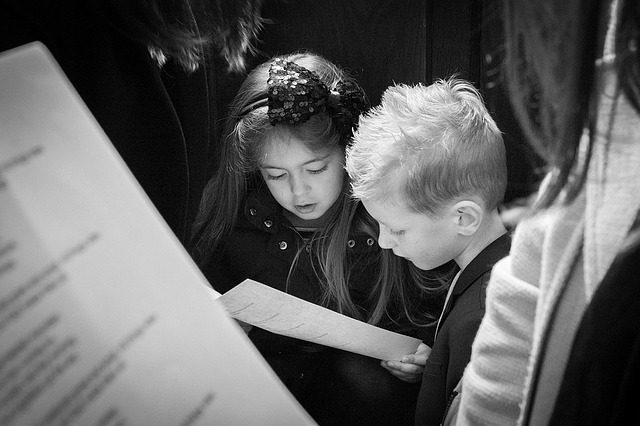Everyone can sing.
Yes, you can. Everyone can sing.
Our culture is obsessed with musical superstars. We see American Idols high and lifted up as the pinnacle of vocal prowess. The commercial music industry has furthered the idea that those who can truly sing should be rewarded with recording contracts, while others are better off sitting and being spectators. Those who love to sing but feel they are lacking in talent will relegate themselves to singing along with the radio, or only sharing their voices with an audience of shampoo and conditioner bottles.
Sadly, instead of counteracting the myth that singing is something only a few are born to do, churches embrace this musical culture. We place a holy microphone in a few select hands, reducing the congregation to an inaudible, unnecessary backup group.
But singing isn’t a talent. It’s a skill, one that must be developed, encouraged, and consistently used. Oh sure, not everyone is a potential Callas or Pavarotti (or, for my fellow baritones, Fischer-Dieskau). But the truth is that everyone can sing. Science tells us that tone deafness is a rarity. Practically anyone with functional hearing can distinguish pitch and learn to replicate it vocally. My experience as an elementary music teacher confirms this. Having taught more than a thousand children in an underprivileged school, I never found a student who, with instruction and practice, couldn’t improve as a singer. Even those who began with monotone droning would show some improvement over time.
Everyone Used to Sing
Further countering the idea of the non-singer is the fact that we know in generations past, basically everyone did sing. They sang in church. They sang at home. They sang at civic functions. The turning point, I believe, came about in 1877 with the invention of the phonograph. Yeah, thanks, Mr. Edison. The phonograph, of course, led to commercial recordings, and ultimately, the recording industry. A funny thing happened over time. Music slowly began to surround us as never before, but people stopped singing. We started consuming mass quantities of music, but the discipline of actually making music has rapidly declined. So the skill of singing, which was once nearly universal, is now left up to the “professionals.” Those who don’t seem to have any hint of commercial appeal are discouraged from even trying.
God forgive us for putting up with this mentality in our churches. For worshipers, singing is not something we do merely for enjoyment. It’s not something we do to feel close to God. It’s a sacred discipline, an omnipresent theme in Holy Scripture. We sing because we are called to sing. We sing because we are able to sing. We sing because it adds unity and dimension to the sacred work of liturgy. And as we sing, God sings with us and through us, transforming us into God’s likeness.
Consider this quote from Basil:
“The Holy Spirit sees how much difficulty mankind has in loving virtue, and how we prefer the lure of pleasure to the straight and narrow path. What does he do? He adds the grace of music to the truth of doctrine. Charmed by what we hear, we pluck the fruit of the words without realizing it.”
The non-singer mentality is epidemic in Christian culture, and we’ve got to do something about it. With all the might of commercial entertainment fighting against us, it won’t be easy, but here are a few steps toward mobilizing our vocal chords once again.
Resist the Superstar Music Culture
The worship band/worship leader format has adopted the “music for consumption” model, and it has decimated congregational singing. Return singing to the people.
- Eliminate the soloist if possible.
- Keep amplification to a minimum. Amplification can be a huge barrier to good congregational singing. It’s much easier to join in with unamplifed singing than to try and find your place in a wall of electronic sound. If possible, eliminate or reduce the amplification, so that the congregation learns to take initiative and not defer to an overpowering soloist.
- Sing hymns and songs that are meant for communal participation, not solo performances.
- Require those in musical leadership to sing with a clear, pure, unaffected tone. You know, like your elementary music teacher taught you. You’re (hopefully) not in a coffee house or a concert hall. Don’t ad lib. Riffing, improvising, and embellishing add no substance to the task at hand, but they do make it nearly impossible for a congregation to be the primary voice. Bluntly, don’t sing so that people will want to listen. Sing so they are able to confidently join you.
Realize that Music Is Not Just for Self-Expression
Again, the purpose of congregational singing isn’t to facilitate a mystical connection between individual and the Divine. According to Simon Chan, this is precisely the problem with much church music.
“Music (including songs and dance) can be an effective way of strengthening the church’s communal consciousness and collective memory, yet all too often in the ‘contemporary’ service, modeled on the entertainment world, singing is turned into a means of individual self-expression. If music is to fulfill its intended purpose in worship, it has to be understood as an important medium through which the various components of worship retell the Christian story.”
When we make singing primarily about the individual’s self-expression, it becomes an option instead of a communal project requiring everyone’s participation.
Stop Normalizing the Idea of the Non-Singer
Church leaders, especially pastors, priests, and other clergy, should never be caught making silly, lame excuses for anyone. We’ve all heard this sort of thing in church culture.
“I can’t sing, but if you can, consider joining our choir!”
“My spouse likes to say that I couldn’t carry a tune in a bucket.”
“He only sings solo: ‘so low’ you can’t hear him.”
Some may find this sort of attitude amusing. As a church musician whose life purpose is to draw the song out of the congregation, it is supremely frustrating. Anyone can sing. Everyone can improve their ability to carry a tune. All of us should be able to sing audibly in the congregation without fear of judgment. It’s sad enough that clergy – those who bear liturgical responsibility for their charge – harbor these feelings of inadequacy about themselves. But perpetuating the myth of the non-singer, even in jest, is tragically detrimental to the communal life of faith.
Teach Your Kids (and Yourselves) to Sing
Create a culture of singing within the life of your congregation.
- Bring back the choirs for all ages.
- Build a resonant worship space.
- Support the fine arts in your community.
- Sing all the time, not just in worship.
- Foster individual musicianship.
Above all else, operate under the assumption that everyone, especially your children, can sing. Encourage all of them to do it, even if they appear slow in developing the skill.
Remember that Relearning to Sing Will Take Time
Congregational singing wasn’t destroyed overnight, and it won’t be relearned overnight. But in time, implementing these ideas would begin to build a singing culture in our congregations once again. It will take a concerted effort. It will take patience. It will take making changes that aren’t popular with everyone or that might not immediately resonate with the culture around us.
That’s okay.
We [all] sing a different song.
Photo:
www.pixabay.com















